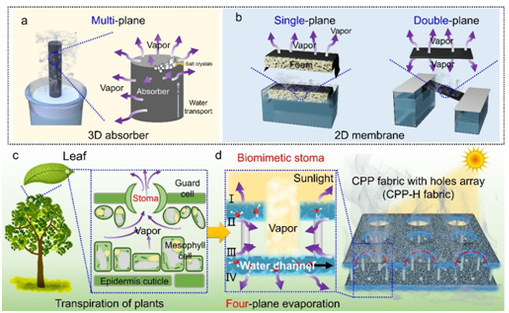2D photothermal membranes have demonstrated numerous advantages in solar desalination due to their flexibility, scalability, and low cost. However, their practical applications are limited by the restricted evaporation area and obstructed vapor channels. A biomimetic design of the breathable 2D photothermal fabric is reported, which is composed of two carbon-nanotube-hydrogel-coated polyester (PET) fabrics separated by fiber pillars, with the upper fabric layer having a hole array as stomatal channels. This fabric shows high solar-absorption efficiency (96.1%) and decreased water-evaporation enthalpy (1664.6 kJ kg−1). The hanging fabric as a heliotropic evaporator exhibits four-plane evaporation feature and achieves a high evaporation rate of 2.6 kg m−2 h−1 under sunlight (1.0 kW m−2) illumination, better than the traditional floated model (single-plane, 1.6 kg m−2 h−1). The evaporation rate can be further enhanced to 4.2 kg m−2 h−1 upon introducing adscititious airflow (2 m s−1). Simultaneously, the heliotropic-hanging design allows the dropping of concentrated brine, avoiding solid-salt-crystallization.

The related research result has been published in Advanced Materials under the title Biomimetic Design of Breathable 2D Photothermal Fabric with Three-Layered Structure for Efficient Four-Plane Evaporation of Seawater. Doctoral student Hu Jinjing from the National Key Laboratory of Advanced Fiber Materials at Donghua University and the College of Materials Science and Engineering is the first author, with Researcher Chen Zhigang as the corresponding author. The study also received guidance and support from Professor Wei Yan at Tsinghua University.
